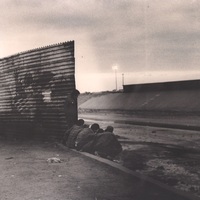
CIBS UTEP
This is a repository for working papers in border studies from the University of Texas at El Paso. We accept volunteered papers, when suitable. Inquiries can be sent to cibs@utep.edu . Requests to use or publish papers should be directed to the lead author identified on the paper.
Address: Center for Interamerican and Border Studies
University of Texas at El Paso
500 W. University Ave.
El Paso, TX 79968 USA
Address: Center for Interamerican and Border Studies
University of Texas at El Paso
500 W. University Ave.
El Paso, TX 79968 USA
less
Related Authors
Paola V Suárez Ávila
UC Berkeley
Eduardo Torre Cantalapiedra
El Colegio de la Frontera Norte
Estefania Cruz Lera
UNAM Universidad Nacional Autónoma de México
Jonathan Fox
American University
Xóchitl Bada
University of Illinois at Chicago
Eileen Truax
Universitat Autònoma de Barcelona
Ariel Mojica
El Colegio de Michoacán
InterestsView All (24)









Uploads
Papers by CIBS UTEP
In sum, our primary data was designed to conduct a multilevel analysis on citizenship profiling along the U.S.- México border that allowed for an investigation of individual and neighborhood effects. To date, we have gained important insights on the implications of policing immigration at the individual-level from qualitative and policy analyses that revealed an array of negative consequences including racial profiling and criminalization of Latina/os (Heyman, 2010; Kennis, 2011; Longazel, 2013; Provine et al., 2016; Provine and Sanchez, 2011; Saenz et al., 2011), removal and deportation (Armenta, 2016; Provine et al., 2016; Golash-Boza, 2012; Motomura, 2011), and compromising community policing efforts (Nygun and Gill, 2016). At the neighborhood-level there has been less attention given to the policing of immigration. An important exception is Mary Romero’s (2006) analysis of the Chandler Roundups in Arizona who found residents of Latina/o neighborhoods being disproportionately targeted. We contribute to this scholarship by establishing that first- and second-generation individuals and those who reside in neighborhoods characterized by poverty and mid-level of enclavishness are disproportionately questioned about their citizenship status by law enforcement.
La violencia y la corrupción relacionadas con las
drogas demuestran que la guerra contra el
narcotráfico en los Estados Unidos es un
problema serio. Los jóvenes se sienten atraídos
hacia los mercados de drogas ilícitas por el alto
precio de las drogas inducido, de manera
artificial, por la política. Se presenta un estudio
de la información sobre la relación entre las
drogas y la violencia. La teoría económica y la
ingeniería de sistemas se aplican a la política de
las drogas, demostrando que la confiscación no
restringe el suministro sino que en realidad,
fortalece los carteles. Se establecen conclusiones
sobre las investigaciones y los argumentos.
Looking at the Blackfoot Confederacy contributes to scholarship investigating Indigenous peoples’ negotiation of international boundaries bisecting aboriginal homelands. This growing body of work has emphasized the social and cultural dimensions of these histories, but there remains room to explore the legal implications of overlapping state, territorial and national jurisdictions; and the confusion resulting from Canadian and American treaties made with Native people throughout the borderlands. A critical legal perspective is especially important for Native peoples straddling the international boundaries and confronting reservation borders. As observed by Dudziak and Volpp, “Law is an important technology in the drawing of dividing lines between American identities and the boundaries (or lack of boundaries) around American global power. Borders are constructed in law, not only through formal legal controls on entry and exit but also through the construction of rights of citizenship and noncitizenship, and the regulation or legitimation of American power in other parts of the world.” Because these boundaries are constructs of law, they are crucial sights of deconstruction.
Borrowing from such insights, this chapter will focus on Blackfoot bands and families that negotiated the legal contradictions and jurisdictional complexities of life as transnational actors in the U.S – Canada borderlands. Between 1855, with the signing of the Blackfoot Treaty in the U.S., the signing of Treaty 7 in Canada in 1877, and the onset of World War One, Blackfoot bands confronted numerous international, national, territorial, provincial, and tribal legal regimes. At the borderlands of two imperial nation-states, Blackfoot bands encountered “legal voids” between competing notions of Indigenous sovereignty, wardship, and national citizenship. These voids and contradictions stem largely from the colonial nature of “Indian Law” as a combination of erasure and extermination on the one hand, and racial assimilation and transformation on the other. 4 South of the “Medicine Line,” Blackfoot people saw their status deteriorate as courts redefined them as wards of the state that lacked legal personhood and the protections of the Constitution. North of the line, Canada promoted assimilation and tried to extinguish Native land title. These related Indian policies signaled the settler-colonial mindset of Canadian and U.S. officials, but implementation at the edge of the U.S. and Canadian Dominion exposed fractures legal through which Niitsitapi survived a changing world.
In sum, our primary data was designed to conduct a multilevel analysis on citizenship profiling along the U.S.- México border that allowed for an investigation of individual and neighborhood effects. To date, we have gained important insights on the implications of policing immigration at the individual-level from qualitative and policy analyses that revealed an array of negative consequences including racial profiling and criminalization of Latina/os (Heyman, 2010; Kennis, 2011; Longazel, 2013; Provine et al., 2016; Provine and Sanchez, 2011; Saenz et al., 2011), removal and deportation (Armenta, 2016; Provine et al., 2016; Golash-Boza, 2012; Motomura, 2011), and compromising community policing efforts (Nygun and Gill, 2016). At the neighborhood-level there has been less attention given to the policing of immigration. An important exception is Mary Romero’s (2006) analysis of the Chandler Roundups in Arizona who found residents of Latina/o neighborhoods being disproportionately targeted. We contribute to this scholarship by establishing that first- and second-generation individuals and those who reside in neighborhoods characterized by poverty and mid-level of enclavishness are disproportionately questioned about their citizenship status by law enforcement.
La violencia y la corrupción relacionadas con las
drogas demuestran que la guerra contra el
narcotráfico en los Estados Unidos es un
problema serio. Los jóvenes se sienten atraídos
hacia los mercados de drogas ilícitas por el alto
precio de las drogas inducido, de manera
artificial, por la política. Se presenta un estudio
de la información sobre la relación entre las
drogas y la violencia. La teoría económica y la
ingeniería de sistemas se aplican a la política de
las drogas, demostrando que la confiscación no
restringe el suministro sino que en realidad,
fortalece los carteles. Se establecen conclusiones
sobre las investigaciones y los argumentos.
Looking at the Blackfoot Confederacy contributes to scholarship investigating Indigenous peoples’ negotiation of international boundaries bisecting aboriginal homelands. This growing body of work has emphasized the social and cultural dimensions of these histories, but there remains room to explore the legal implications of overlapping state, territorial and national jurisdictions; and the confusion resulting from Canadian and American treaties made with Native people throughout the borderlands. A critical legal perspective is especially important for Native peoples straddling the international boundaries and confronting reservation borders. As observed by Dudziak and Volpp, “Law is an important technology in the drawing of dividing lines between American identities and the boundaries (or lack of boundaries) around American global power. Borders are constructed in law, not only through formal legal controls on entry and exit but also through the construction of rights of citizenship and noncitizenship, and the regulation or legitimation of American power in other parts of the world.” Because these boundaries are constructs of law, they are crucial sights of deconstruction.
Borrowing from such insights, this chapter will focus on Blackfoot bands and families that negotiated the legal contradictions and jurisdictional complexities of life as transnational actors in the U.S – Canada borderlands. Between 1855, with the signing of the Blackfoot Treaty in the U.S., the signing of Treaty 7 in Canada in 1877, and the onset of World War One, Blackfoot bands confronted numerous international, national, territorial, provincial, and tribal legal regimes. At the borderlands of two imperial nation-states, Blackfoot bands encountered “legal voids” between competing notions of Indigenous sovereignty, wardship, and national citizenship. These voids and contradictions stem largely from the colonial nature of “Indian Law” as a combination of erasure and extermination on the one hand, and racial assimilation and transformation on the other. 4 South of the “Medicine Line,” Blackfoot people saw their status deteriorate as courts redefined them as wards of the state that lacked legal personhood and the protections of the Constitution. North of the line, Canada promoted assimilation and tried to extinguish Native land title. These related Indian policies signaled the settler-colonial mindset of Canadian and U.S. officials, but implementation at the edge of the U.S. and Canadian Dominion exposed fractures legal through which Niitsitapi survived a changing world.